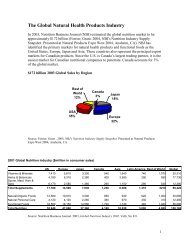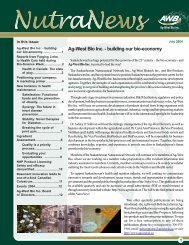Beyond Borders: Global biotechnology report 2010
Beyond Borders: Global biotechnology report 2010
Beyond Borders: Global biotechnology report 2010
Create successful ePaper yourself
Turn your PDF publications into a flip-book with our unique Google optimized e-Paper software.
European Phase III pipeline by indication, 2009<br />
Autoimmune<br />
12%<br />
Metabolic and endocrine<br />
13%<br />
Cancer<br />
22%<br />
Source: Ernst & Young, MedTRACK and company websites<br />
European approvals<br />
The EMA was active in approving products<br />
for a variety of therapeutic categories,<br />
including cancer, neurology, cardiovascular,<br />
metabolic disorders and immunology.<br />
Most products approved by the EMA<br />
were from US-based companies or large<br />
pharmaceutical organizations; however, a<br />
handful of European-based biotechs secured<br />
approvals as well.<br />
Belgium-based TiGenix received EMA<br />
approval for ChondroCelect, a cartilagerepair<br />
therapeutic, in October. The<br />
cell-based medicinal product consists of<br />
chondrocytes (cartilage-forming cells)<br />
that are taken from a healthy region of a<br />
Neurology<br />
11%<br />
Other<br />
20%<br />
Inflammation<br />
9%<br />
Infectious disease<br />
6%<br />
Cardiovascular<br />
7%<br />
patient’s cartilage, grown outside the body,<br />
and then surgically re-implanted. Belgiumbased<br />
UCB also garnered market approval<br />
in Europe for its drug Cimzia for rheumatoid<br />
arthritis. Cimzia had previously gained US<br />
marketing authorization for moderate-tosevere<br />
Crohn’s disease.<br />
Other approvals included Ferring<br />
Pharmaceutical’s Firmagon in February for<br />
patients with advanced prostate cancer.<br />
Firmagon was previously approved by the FDA<br />
in 2008. Orphan Europe’s product Vedrop<br />
was approved for cholestatis, a condition<br />
in which the flow of bile from the liver is<br />
blocked. Victoza, a Novo Nordisk product, was<br />
approved for type 2 diabetes in June.<br />
90 <strong>Beyond</strong> borders <strong>Global</strong> <strong>biotechnology</strong> <strong>report</strong> <strong>2010</strong><br />
European companies also received FDA<br />
approval for a number of products in 2009.<br />
GlaxoSmithKline received accelerated<br />
approval in October 2009 for Arzerra,<br />
a treatment for refractory chronic<br />
lymphocytic leukemia. Arzerra, which<br />
GSK obtained through a collaboration with<br />
Genmab, is a monoclonal antibody that<br />
causes the body’s immune response to<br />
fight against normal and cancerous B-cells.<br />
Azerra went on to receive conditional<br />
approval in Europe in January <strong>2010</strong><br />
for the treatment of refractory chronic<br />
lymphocytic leukemia (CLL), but only for<br />
the approximately 25% or so of patients<br />
who do not respond to the standard<br />
therapies fludarabine and alemtuzumab,<br />
which EMA has already approved.<br />
Lundbeck secured two approvals in 2009.<br />
Its Sabril, for treatment of infantile spasms<br />
in pediatric patients and refractory complex<br />
partial seizures in adults, was approved in<br />
August 2009. Earlier in the year, Lundbeck<br />
licensed Atryn from GTC Biotherapeutics<br />
and received approval for the antithrombin<br />
deficiency medication in February.<br />
In another licensing deal, Cypress<br />
Bioscience licensed Savella from French<br />
drug-maker Pierre Fabre and then signed<br />
a commercialization agreement with<br />
Forest Laboratories. In January, the FDA<br />
approved the product for the treatment<br />
of fibromyalgia. Milnacipran was originally<br />
approved in France in 1996 for major<br />
depression episodes but was introduced in<br />
the United States for the first time with the<br />
fibromyalgia indication.<br />
Outcomes-based pricing arrangements<br />
Facing mounting pricing pressures,<br />
payors are seeking ways to leverage<br />
pay-for-performance reimbursement<br />
mechanisms. In this environment,<br />
risk-sharing pricing arrangements — where








